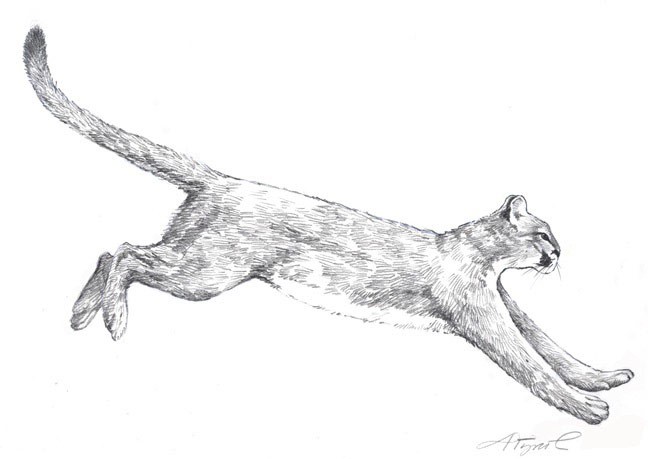
More than 70 years have passed since a mountain lion was hunted and killed in New England. In 1938 a Quebec trapper caught the last one on record—in Maine. New Hampshire’s last killing occurred in the White Mountains in 1885. Alexander Cromwell shot the final and largest specimen ever recorded in Vermont in Barnard in 1881. It weighed 182 pounds and measured seven feet. A mount of this magnificent animal, with Cromwell’s rifle, is displayed at the Vermont Historical Society in Montpelier.
The mountain lion — a.k.a. cougar, puma, panther or catamount (cat of the mountain) — has long occupied a mythic role in the region. In his 1853 book, “Natural History of Vermont,” renowned naturalist Zadock Thompson mentioned the strength and leaping ability of the mountain lion. “One of these animals took a large calf out of a pen in Bennington, where the fence was four feet high, and carried it off on his back,” he wrote. “With this load, he ascended a ledge of rocks, where one of the leaps was 15 feet in height.”
In the mid 1800s, mountain lions were considered such a threat to human life and livestock that the Vermont Legislature issued a bounty of $20 for each pelt. Adjusted for inflation, that would have equaled about $550 in today’s dollars. The bounty and civilization have had an impact, for in the East the mountain lion as a species has virtually disappeared.
Nonetheless, residents of northern New England seem to be on the lookout for them. Wildlife biologists in the region get plenty of reports of sightings, but most reports are cases of mistaken identity —what people are seeing most likely are bobcats, lynx, coyotes, or domesticated mountain lion escapees.
Time and again, biologists play Sherlock Holmes, taking testimony from those reporting sightings and combing the outdoors for tracks, fur and scat. They wield forensic tools worthy of a contemporary CSI crime drama—detailed lab exams of suspect droppings and DNA analysis of purported catamount fur.
Mountain lions are noticeably larger than the other large mammals for which they are mistaken. A mountain lion can weigh well over 150 pounds, while a bobcat might weigh up to 35 pounds and reach 45 inches (tip of nose to end of tail); a coyote 50 pounds and 53 inches; or a lynx 35 pounds and 40 inches.
Wild populations of mountain lion survive in southern Florida and in mountains of the West. They make dens in caves and crevices, amid boulder outcroppings, and in dense underbrush. They range as far as 30 miles from their dens and eat as much as 12 pounds of prey per day — from rabbit to deer.
With western populations increasing, wildlife biologists conjecture that individual lions may be dispersing eastward. Catamounts have been spotted in New Brunswick, Ontario, Nova Scotia and in a few parts of New England, but a confirmed sighting does not necessarily mean that the animal has taken up residence.
Douglas Blodgett, a wildlife biologist with the Vermont Fish & Wildlife Department, says “40 to 50 sightings” of catamounts are reported in Vermont each year. “But we still don’t have tangible, solid evidence, such as scat, prey caches or dead mountain lions. There is no evidence of a viable catamount population in Vermont.”
Blodgett, however, keeps an open mind. “On occasion, some of the sightings are very credible,” he says. “These sightings could be explained by the exotic pet trade, which is ubiquitous in the United States. It’s not beyond belief that some of these animals could have been purchased and escaped.”
Still, a mature mountain lion and two cubs apparently were sighted in Craftsbury, Vt., during the winter of 1993-‘94. Their scat contained fur that Fish & Wildlife officials determined, through microscopic analysis, to be that of a catamount.
“There is no definitive proof of mountain lions in New Hampshire (either), says Mark Ellingwood, a wildlife biologist with that state’s Fish and Game Department. “DNA analysis of scat and hair samples have all been negative … mostly bobcats,” he says.
Sounding like a detective, Ellingwood says: “We look for patterns in the evidence and look forward to receiving any evidence, particularly physical evidence. I have spoken to some very knowledgeable and very competent people who say they’ve seen mountain lions.”
Maine’s Department of Inland Fisheries and Wildlife reports tracks, droppings and fur from catamounts in that state and neighboring New Brunswick. In 1997, Massachusetts biologists found scat near the Quabbin Reservoir. DNA analysis proved it was from a mountain lion, but some officials suspect it was a domesticated animal that had escaped.
So the search continues. If Sherlock Holmes were sleuthing the mountain lion today, he might doggedly turn to his sidekick and say, “Come Watson, come! The game is a … paw.”


Discussion *